Always up to date
Sign up for our newletter
Get updates on new products, sales, and helpful tips. Plus special subcriber only exclusives!
SIGN UP!I never had a desire to ride a bucking bronco. If I did I would have joined the Rodeo. Instead I prefer to ride my horses safely making sure if there was a bucking fest it came from training or exuberant expression (my nice way of saying they were being a naughty pony!) and not from pain. This first and foremost means my saddle must fit. If you have ever tried finding a saddle to fit an Arabian then you have stared adversity in the face and stated “I have got this!” Why?
Let’s clarify adversity: if you have ever called a saddle fitter and told them you were having trouble finding a saddle to fit and then the word “Arabian” came out of your mouth you could almost hear the crickets against the silence. In the saddle fitter world Arabians are known for being tough to saddle fit, not impossible but tough. Some saddle fitters relish in the challenge, others slowly back away never to be heard from again. It isn’t that Arabians are not particularly suited to being ridden, quite the contrary but the modern Arabian Sport Horse has become so athletic it has some unique fitting challenges to go with that athletic conformation and quite frankly many saddle manufactures just haven’t caught up. I thought I would pass on a little bit of knowledge I gained over the years trying to fit the impossible to fit Arabians.
For starters an Arabian horse in general has a straighter top line…please note I said in general, I currently have one Arabian that has anything but a level top line. The modern Arabian sport horse also in general has wide broad shoulders, a well sprung rib cage, a short back that is also well muscled with an equally well muscled and active loin. These horses are short coupled with well laid back shoulders and being fantastic elastic “back movers” it is amazing we don’t need super glue and duct tape to keep a saddle on them. Arabians in general do not have substantial withers. The good news is all these features make a spectacular riding horse.
The first thing I learned over the years of having Arabians is: there is no such thing as an Arabian saddle. I know, I know, before you yell “But there is the Arabian Saddle Company and Circle Y makes a Western Saddle on an Arabian tree/bar”, yes, I know there are companies who market saddles for Arabian horses. That said that does not mean it will fit YOUR Arabian. While there are some generalities every horse has its own unique conformation so just because a saddle is labeled “Arabian” doesn’t guarantee its fit. Is it a good starting point? Maybe. While there are some generalities I will describe we know Arabians all have their own unique conformation, like snowflakes, no two are exactly alike. The problem is saddle fit is also like shoe fit, it must be perfect or it pinches, rubs, and shifts, and makes your horse miserable, and like shoe fit most of us can’t afford custom. If you have spent one day in a pair of ill fitting pair of shoes then you understand the importance for our horses.
I am “ok” with making a few generalities about Arabians but remember there are exceptions and it should be about evaluating the conformation in relation to the breed not the breed itself. One of the most common generalities in Arabian saddle fitting is the fact that many Arabians have a shorter back or more specifically 22 vertebrae versus 23 (five lumbar 17 thoracic) that you see in many other equine breeds. Keep in mind this doesn’t apply to all Arabians. Another generality is many Arabians are flat backed, primarily because they have well sprung ribs. If your horse also has little to no withers (mutton withers) saddle fitting these guys is a bit like finding a saddle to fit a small propane tank. If your horse has moderate withers it more than likely also flattens out immediately after the wither “joins” the back.
Here are some examples of a true “flat backed” Arabian:
Notice the withers flows smoothly into the back with little wither definition. Table for two anyone?
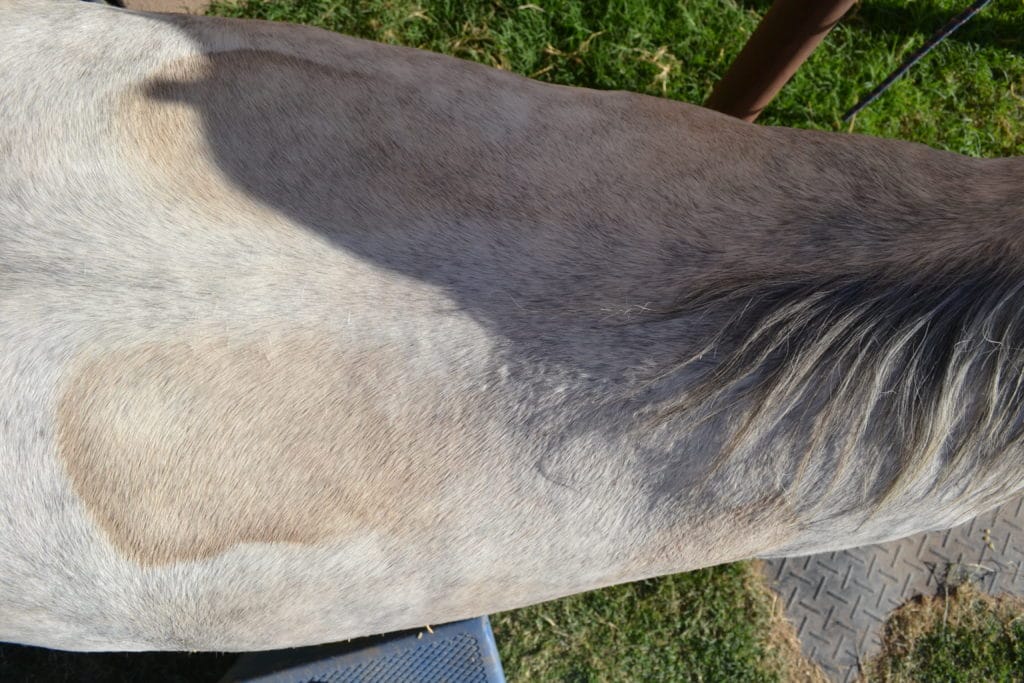
Saddle seat marks can be a useful indicator whether a saddle is fitting. It can also be complete nonsense. Just depends who you ask. Clear as mud? Welcome to my world.
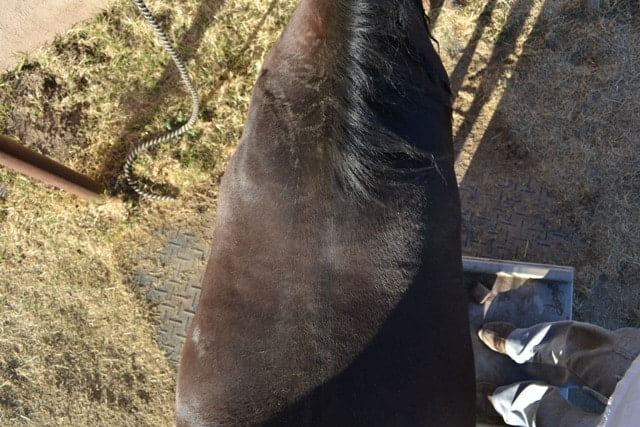
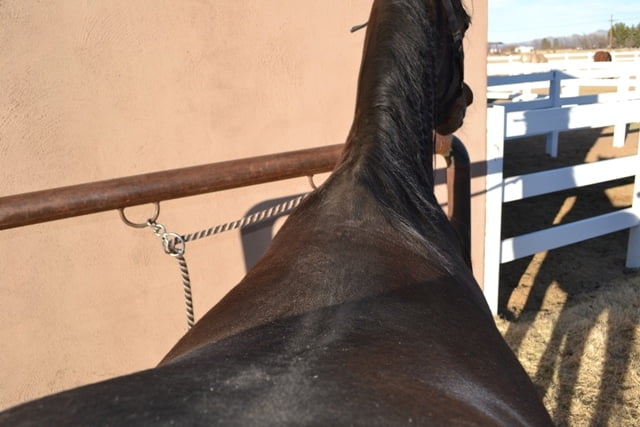
Here is an example of a combination “A” withers in to flat back.
The side shot shows best the difference in conformation. This mare has an “A” framed wither but immediately flattens out after the wither joins the back, this is a tough fit as most saddles that are designed on a hoop tree, think an upside down “U” which is relatively flat all through the gullet and rails of the tree, or in an “A” framed saddle which looks like it sounds in a more “V” shape all the way down. This particular mare has a “board” straight back, I even laid a 2 x 4 over her back just to prove my point, it was a near perfect “fit”. This mare is a combination fit.
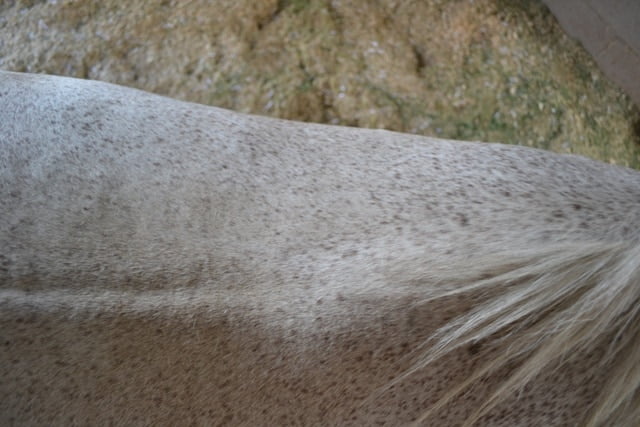
Here are the above three horses in order from the side, don’t they look harmless, not the absolute saddle fitting nightmares I have made them out to be?
Horse top left is a stallion, horse top right is a broodmare who has had three foals, and horse bottom right is a mare who had had one foal. Despite their very different backs, they are all Arabians. Do you notice something all three have in common? While they have very well developed loins, all of them have a downward slope of the back into the withers. This is very common in Arabians and can contribute to saddles moving forward on the horse if the saddle does not properly follow the contours of the horse’s back.
Here this photo may illustrate a bit better:
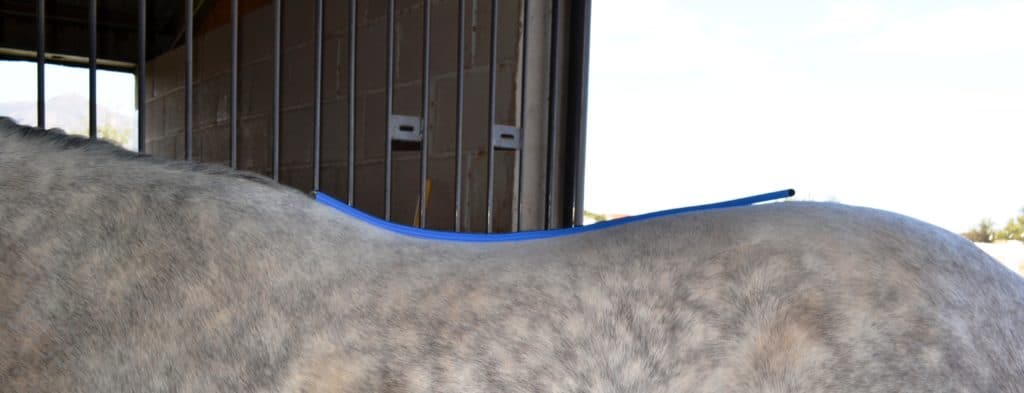
Do you see that the back ties in slightly down hill? What else do you notice about these arabians?
Did you get it? Forward girth grooves. You see along with those well sprung rib cages and laid back shoulders comes a very forward girth groove. If you draw a line straight up from this mares normal girth groove you would be on top of her neck almost. Surely we can’t put a saddle there can we? Do you see how forward this mare’s natural girth spot is from where the billets would join in? Well now what? I guess I have a driving horse you tell yourself…nahhh…I like adversity remember?
In a traditional billet system the saddle would be pulled forward on the mares shoulders no matter how well fitting the saddle was otherwise. Girths always travel to the smallest circumference I don’t care how many “anti-slip” pads you use. Thus, many Arabians with this type of conformation need a point billet, v billet combination and/or an anatomic girth for forward girth grooves. Here is a picture of a point/v billet combination. Hard to see the “v” part but it’s there, promise. Are we having fun yet?
Please notice the point billet is correctly named as the billet comes of the “point of the tree, or more correctly the gullet points” while the “V” billet acts as a counter balance to discourage rocking which can cause the saddle to travel on to the shoulders. In some saddles the saddle maker actually runs the point billet down through the knee roll, this is good for extreme cases but generally overkill. Some argue that a point billet puts unnecessary pressure over the scapula. First, I argue the point of your tree should not be ON the scapula but behind it, second, I never tighten a point billet as tight as I do the corresponding “V” billet, always one notch looser. This allows for complete freedom of the shoulder while still doing its job of keeping the saddle balanced. That is just my experience, but every horse has a different comfort level and if the saddle fits well in other areas it shouldn’t be creating undue pressure. I find an ill fitting saddle that travels onto the horse’s shoulders intolerable by most horses and something that should be an immediate concern to address if your horse is having that issue. It is also a safety hazard for you, as these horses may rear, bolt, or buck to evade the pain. Now here are the most common reasons a saddle travels forward: it is too narrow, or most common in arabians, the base of the pommel arch is too narrow, or not flat enough, or does not become flat enough for said horse. If you have ever girthed up what you thought was a plenty good fitting gullet/tree, lined up with the shoulders, great angles, and then the horse walked…. and “pop” goes up the back end of the saddle, you have experienced a pommel base problem (it could also be too wide). (An ahaaaa moment just happened didn’t it?) So what’s a pommel base? Well you know that “twist” riders are always asking about? Well in the same area we develop the seats twist, below that is the pommel base, and it determines how quickly a tree narrows, or flattens. So with a rare few exceptions (saddle manufacturer wise), you can’t have a narrow twist on a horse who needs a wide pommel base. So get to yoga, start your stretches, because you bought a wide horse, and a wide horse you shall ride.
I find many people in other breeds concerned about wither height and there are certainly Arabians with this issue as well but I have had more struggles with the LENGTH of the Arabian wither as it is long and sloping.
Where exactly does this horse’s withers end…oh yes about mid-point of his back. Keep in mind the channel of the saddle must be wide enough to accommodate the withers AND the spine all the way down, including the nerves and ligament that run along-side it. If you have long, wide mutton withers that taper well in to the back then you need two things, at least a hand widths channel if not more (depends on the horse) and a saddle where the scoop of the tree is slightly sloping, deep seats are a “no no” on these types of horses because seat profiles generally match tree shape…where they don’t you have so much padding between you and the horse is makes for a complete lack of contact something in my opinion you can’t afford not to have when riding Arabians…just my two cents. There are exceptions of course:.
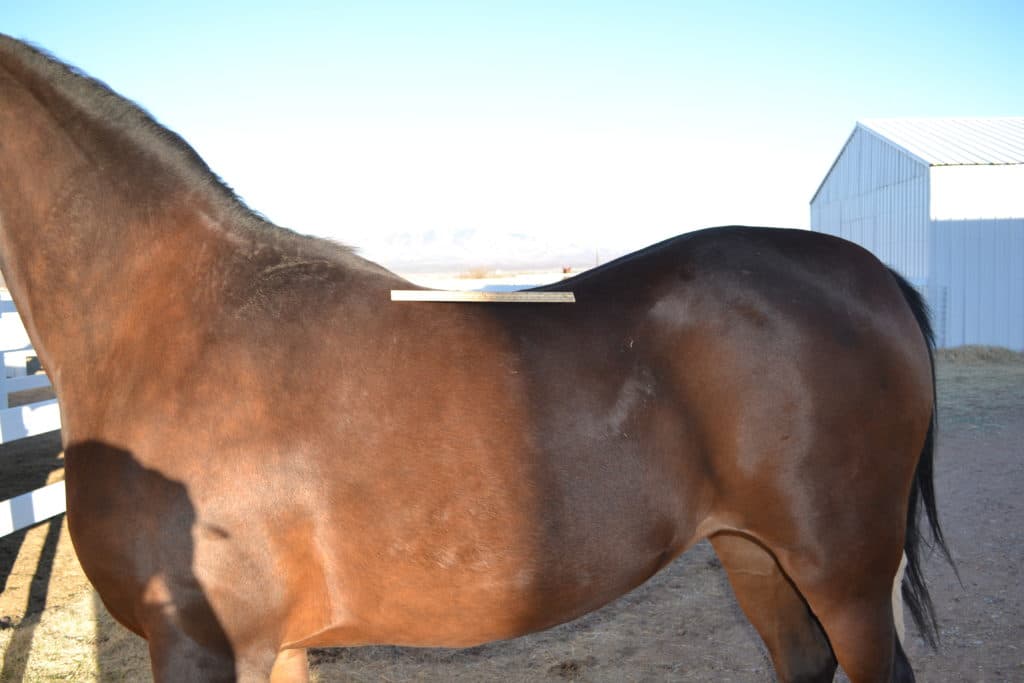
This mare has moderate withers; they are long, but just when her withers end her loin begins! Not to mention she is a broodmare so she has a dippy back from foaling. A curvier tree was an absolute necessity on this mare until proper training improved her top line. What would happen if I put a saddle with straighter panels and rails on this mare? It would bridge creating pressure points. Also while we all know Arabians have short backs, this mare has the shortest back of any horse I have ever seen…that is a ruler 12 inches long.
Fine ok, so Arabians just need a hoop tree, a wide tree, and/or modified hoop tree? Now you are really going to hate me….the answer is not necessarily. See this guy right here is a purebred Arabian too:
Noooooo!!!! I know I am such a meanie. Just when you thought you had it iced down to something simple I pulled a fast one. This horse’s saddle is not a hoop tree, he has an uphill build, and an “A” framed build but does flatten through the back and 100% Arabian. Does have a nice short Arabian back though.
I am not going to discuss wither tracings, proper gullet width/shape and making sure the angles of the tree points align correctly as I think there are a number of very good saddle fitting articles that already address those issues. I will say get yourself a flexible curve ruler and a file folder and trace out your horses withers so you know what you are dealing with. I am still surprised sometimes at a fitting with how round a horse is “on paper”.
I once had a saddle fitter tell me “Some horses just are not made to wear a saddle”. That was the last time I saw him. I can’t say I blame him, the look I gave him was probably enough for him to want to clear the country permanently, ha ha! Seriously though he is still a saddle fitter…somewhere 🙂
Truth is the horse isn’t the problem, many saddle makers are not keeping up with the modern sport horse conformation and this is not just in the Arabian breed either. While many saddle fitters recommended “re-flocking this and re-flocking that” I believe in re-flocking for minor corrections and focusing on the fact that the basic shape of the tree, rails, and panels must match not just a static horse but also one that moves. I have had many saddles that looked perfect standing still only to rock more than a see-saw when the horse started moving.
I did manage to find saddles to fit all three horses above despite their unique conformation and countless shipping of saddles back and forth. This is why I now own a tack store. Here is a list of saddles I have had luck with fitting Arabians, please note this does NOT mean these saddles will necessarily fit your Arabian. If anything I hope this article explains to look at the horse’s conformation not breed when selecting saddles to fit your horse.
No particular order:
Adam Ellis: He makes a lovely hoop tree and these bad boys have a super open head. Not super straight, not super curved, in between.
Fairfax Saddlery: Low Wither Dressage, great for compact horses, the rear gusset is great for downhill built horses too.
Frank Baines: Specifically the Reflex/Pirouette dressage for combination backs that are fairly straight in the top line. They make a rear gusset option, if your Arabian is built downhill talk to your saddle fitter about a rear gusset. FYI, their Reflex jump is not on the same tree as the dressage, it will not fit the same, it’s more A framed. Ask me how I know. 🙂
Black Country: The Eloquence X, their hoop tree models tend to work very well on flatter backed “U” shaped Arabians with a slight dip behind the withers.
Arabian Saddle Company/Lovatt and Ricketts: Ellipse for the “U” shape types Berkely for the “A” frames.
Lazer: Trident, not for super straight top line but a moderate long slope, but tends to run long in the panel, if your horse has a bit more length of back but is very broad this is a great saddle for those horses. If you can find an old 100D this is the shortest saddle panel I could find that they make and I literally had them measure every saddle they had at the time!
Bliss of London/ Loxley Saddles. Look for their hoop tree versions. Models Sportiva for straighter toplines, Liberty for curvey. These tend to be shorter pommel heads so work nicely on some arabians.
Duett: If your horse resembles a propane tank, and super wide and round these guys may be your saving grace.
Albion: These guys are very versatile in tree options but struggle with them rocking on flatter toplines. If you horse has more curve to their topline these are a good choice. If it rocks, you need a flatter tree. I know many Arabian horse owners that have very good luck with them. Keep in mind out of shape horses may develop straighter toplines during work, keep reevaluating saddle fit especially if you purchase a curvier type tree.
HDR/Henri De Rivel: Pro Quarter Horse, wider channel slimmer panels good choice for a close contact saddle, the Austal and Dortmund are great choices for “A” framed combination types.
Thornhill: Jorge Canaves Vienna II, built on a hoop tree great for really broad short backs, also the Pro-Trainer Danube, the hoopiest of the Thornhill saddle line.
Bates/Wintec Wide: If your Arabian is truly just really wide but NOT “U” shaped this saddle may be a good choice. Their wide AP saddle was seriously the only saddle ever to fit a rolly polly arabian who resembles more of a barrel than a horse.
Feel free to add your favorites in the comments below.
The above article is for informational purposes only and not meant to diagnose or treat any saddle fitting issues that you may be experiencing. Please consult a qualified saddle fitter in your area. To visit our web site click here: Theconnectedrider.com We are not responsible for any damages as a result of this article and provided for informational purposes only. You may contact us through our website at: theconnectedrider.com if you have any questions or comments or to subscribe to our newsletter click here: Contact Us If you would like to see any of the saddles we have for sale click here: Saddles
Email: info@theconnectedrider.com.